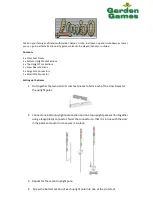
Page 11
The following lessons are suggested as examples of
instructional procedure. They should follow a complete
discussion and demonstration of body mechanics
between the supervisor and the student(s).
LESSON No. 1
1. Mounting and dismounting.
Demonstration and practice of proper techniques.
2. Fundamental bouncing.
Demonstration and practice.
3. Braking (checking bounce).
Demonstration and practice, braking on command.
4. Hands and knees.
Demonstration and practice, stressing four-point
landing and alignment.
LESSON No. 2
1. Review and practice of techniques.
2. Knee bounce.
Half twist to right, to left, to feet, to knees.
3. Seat-drop.
Repeat in swing.
Half twist to feet.
Seat-drop, knees, hands and knees; repeat.
LESSON No. 3
1. Review and practice of skills previously learned.
2. Front-drop.
To save time and avoid mat burns, all members of
the class should be requested to assume the front-
drop position on the floor while the instructor
checks for faults. Suggested progression: From
hands and knees bounce, the body is extended for
the landing in front drop position, and the rebound
is made to feet.
3. Practice routine; hands and knees, front-drop, feet,
seat-drop, half twist to feet.
LESSON NO. 4
1. Review and practice of learned skills.
2. Back-drop.
Demonstration, accenting the forward thrust of the
hips by arching body as one leg is brought forward
from standing (not bouncing) position, and the
drop to the back is made with chin held forward to
chest, eyes forward on trampoline frame. Spotting
this skill is most important. Demonstration of
back-drop with low bounce and practice on both
techniques.
LESSON NO. 5
1. Review of all skills learned, encouraging original
routines based upon them.
2. Half turntable.
Start from front drop position and push left or right
with hands.
Turn head and shoulders in same direction. Keep
back parallel to mat and head up. After completing
1/2 turn land in front drop position.
LESSON NO. 6
1. Swivel-hips.
Suggested progression:
Seat-drop, feet, half twist; repeat.
Seat-drop, half twist to feet; repeat.
Seat drop, half twist to seat drop.
2. Half turntable.
LESSON NO. 7
The student should now be encouraged to design and
organize routines with emphasis on good form. The
instructor may judge or grade the students and arrange
groupings for further instruction accordingly.
To stimulate interest in competition, the game of “Tram-
poline Horse” may be introduced. It is played in the
following manner: The students number off and No. 1
performs a stunt. No. 2 mounts the trampoline and
performs the same stunt and adds another one. No. 3
mounts and does stunts 1 and 2 and adds another one
himself. Thus, it becomes a continually lengthening
series of stunts in routine. The first person who misses a
stunt in the series assumes the letter “H,” and starts the
series over again with the first stunt. If a person misses
again, he accumulates “O” and the first one to accumu-
late H-O-R-S-E is eliminated from the game. The last
remaining contestant is the winner.
Lesson planning from this point should be facilitated by
contacting a certified trampoline instructor.
Instruction Program - Model Lessons












































